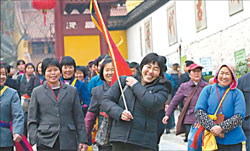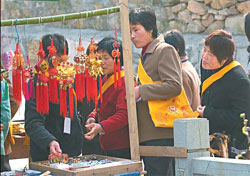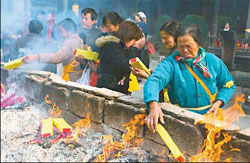New direction for old journey
Rural pilgrims to Hangzhou, of East China's Zhejiang Province, use the Chinese Lunar New Year as an opportunity to relax and leave their work behind. |
Actually, Pu has been coming to this city annually for the past 18 years.
For Pu and her fellow villagers in the neighboring Jiangsu Province, there is nothing more important than making a pilgrimage to the temples in Hangzhou.
The women aged between 42 and 78 fastened yellow lines around their waists carrying yellow Buddhism cotton bags covered in the many red stamps collected during their various monastery visits.
Many pilgrims visiting Hangzhou's temples buy religious souvenirs, which they believe will bring good luck. |
"I think it's very pretty," Pu said with a big smile.
"I don't care what the urban people think about us. It just shows how happy we are. Every year this is the only chance for us to travel."
Their first destination was the Linyin Temple, the biggest Buddhist shrine in the city. Thousands of worshippers had already arrived there to make wishes for the new year.
Hangzhou is a renowned center of Buddhist worship.
More than 1,000 years ago, Qian Liu, founder of the Wuyue Kingdom in the Five Dynasties and Ten Kingdoms (AD 907-960), developed Hangzhou and encouraged Buddhism.
The Faxi, Fajing and Fajin temples on the Tianzhu Hill and the Lingyin Temple became the
Burning joss sticks is a traditional way of paying tribute to the Buddha. |
Every year, thousands of pilgrims flock here from all over the country to visit its sacred sights and temples. Many of the pilgrims are called "canniang" (Silkworm Lady, or female silkworm breeders).
The lower reaches of the Yangtze River where Hangzhou is located has had a 5,000-year-long history of raising silkworms. Women breeding silkworms at home have traditionally brought in about half the families' income as the men laboring in the fields.
Legends say a Silkworm Lady once prayed at Hangzhou temples and her silkworms grew much better. Soon more women came to pray and tour the city as well.
This pilgrimage has evolved into a festival where hardworking women even borrow money to make the trip.
Most of them come from villages or towns in Jiaxing, Huzhou, Suzhou, Wuxi and Changzhou. They visit Hangzhou only once a year during the first three months of the lunar Chinese calendar.
Some 20,000 pilgrims a day crowd into the most famous temples during the peak time.
Their rustic appearances make them appear quite different from modern tourists. In effect, they have become a unique attraction of the city in spring.
An improvement in the standard of living has seen a change in the women's approach to their pilgrimage.
Pu recalled that in the past, her mother made straw mats in her spare time to make money for the trip. It took her at least two days from the village to the city by a small boat. She and other worshippers slept on the boat at night and ate cold sticky rice and fried rice flour to save money.
But now Pu has more options. Boats, trains and buses are available and she can find good food at reasonable price at the temples and hotels.
Lu Aiqing, Pu's fellow villager, said she didn't need to worry about traveling expenses. Her children have set up their own businesses and give her support.
"They know the pilgrimage is my vacation. They want me to enjoy it as much as possible. They've given me more money than necessary. I could become rich via the trip," the 60-year-old joked.
After leaving their luggage at the Fajing Temple, the elders headed for the North Great Hill to pray for good fortune at the temple of the God of Wealth.
Instead of climbing the mountain path, they were fascinated by the cableway, which costs 30 yuan ($3.75) per person.
They crowded at the entrance, and couldn't wait to try the modern transportation that would save them more than hour to get to the top of the hill. Still, a few were reluctant to get inside the cabin, as if it was a spaceship ready to blast them into outer space.
They burst into laughter by mocking at each other, and their smiles smoothed out their heavily creased faces.
The trip includes climbing Tianzhu Road to visit the three temples by foot, where the pilgrims bow at the waist of the hill toward the temples, burn joss sticks, shake spicy smoke up into the air with both hands to communicate with the heavens, and wish for family prosperity.
Besides praying and sightseeing, the pilgrims also shop at the small shops outside the temple. They believe that buying umbrellas, Buddhism accessories, toys, bags and rubbers can bring good luck.
Pu had already bought several umbrellas, but got a headache from finding gifts for her family, who say that the things she buys are old-fashioned.
Hangzhou native Zhao Xiangyong has run a shop outside the Fajing Temple for eight years.
Zhao said the pilgrims are no longer interested in big steel-made pots and enamelware washbasins, instead they prefer accessories and toys for their grandchildren. They also seem to be more fashionable some don't wear head clothes and even carry leather bags.
The number of worshippers who jointly rent a coach to visit the temples has increased rapidly over the past five years. Zhou Juying is one of them.
The Jiangsu native paid more than 200 yuan ($25) for the 3-day trip.
The 55-year-old wore a brocade satin top with a card pinned to her chest, stating the name of the coach company as well as the contact number of the leader, which made her look more like a tourist than a pilgrim.
She said that a "xiangtou" (Pilgrim Head, a person who organizes the pilgrimage in the village) asked them to join the trip to Hangzhou a month before the Spring Festival. When the numbers exceeded 60, the organizer called travel agencies to arrange transportation and accommodation, making the trip much easier for them.
"As a grandmother, I have less domestic chores. There is always something new and interesting in the annual pilgrimage. It goes to show that you are never too old to make the trip."
(China Daily 03/13/2007 page19)

















